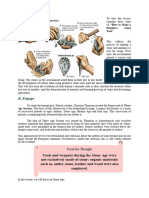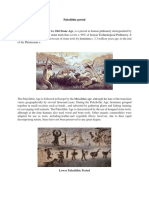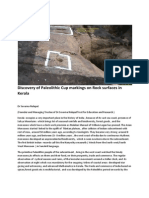Professional Documents
Culture Documents
Stone Age
Stone Age
Uploaded by
Sanjana BhandiwadOriginal Description:
Original Title
Copyright
Available Formats
Share this document
Did you find this document useful?
Is this content inappropriate?
Report this DocumentCopyright:
Available Formats
Stone Age
Stone Age
Uploaded by
Sanjana BhandiwadCopyright:
Available Formats
PICA
Humanities
The Stone Age
Sanjana Bhandiwad 04,
Sayali Said 62
The Stone Age was a broad prehistoric period of human development,
characterized by the creation and use of stone tools. The period lasted roughly 3.4
million years and ended between 8700 BCE and 2000 BCE with the advent
of metalworking. Its origin coincides with the discovery of the oldest known stone
tools, , is usually divided into three separate periods — The Paleolithic Period, The
Mesolithic Period, and The
Neolithic Period, based on the
degree of sophistication in the
fashioning and use of tools.
Stone Age artifacts include
tools used by modern humans
and by their predecessor species
in the genus Homo, and possibly
by the earlier partly contemporaneous
genera Australopithecus and Paranthropus. Bone tools were used during this period
as well but are rarely preserved in the archaeological record. The Stone Age is
further subdivided by the types of stone tools in use.
The Neolithic Age
The Mesolithic Age
The Paleolithic Age
The Paleolithic Period, also
known as the Old Stone Age,
is characterized by the use
of rudimentary chipped stone
tools.
The onset of the Paleolithic
Period has traditionally
coincided with the first evidence
of tool construction and use
by the Homo some 2.58 million
years ago, near the beginning
of the Pleistocene Epoch. In
2015, however, researchers
excavating a dry riverbed near
Kenya’s Lake Turkana
discovered primitive stone tools
embedded in rocks dating to 3.3
million years ago—the middle of
the Pliocene Epoch Those tools predate the oldest confirmed specimens of Homo by
almost 1 million years, which raises the possibility that tool making originated
with Australopithecus or its contemporaries and that the timing of the onset of this
cultural stage should be reevaluated.
Throughout the Paleolithic, humans were food gatherers, depending for their
subsistence on hunting wild animals and birds, fishing, and collecting wild fruits,
nuts, and berries.
• Paleolithic Tool making
At sites dating from the Lower Paleolithic Period (2,580,000 to 200,000 years
ago), simple pebble tools have been found in association with the remains of what
may have been some of the earliest human ancestors. A somewhat more-
sophisticated Lower Paleolithic tradition known as the Chopper chopping-tool
industry is widely distributed in the Eastern Hemisphere and tradition is thought to
have been the work of the hominin species named Homo erectus. It is believed
that H. erectusprobably made tools of wood and bone, although no such fossil tools
have yet been found, as well as of stone.
About 700,000 years ago a new
Lower Paleolithic tool, the hand ax,
appeared. The earliest European
hand axes are assigned to
the Abbevillian industry, which
developed in northern France in the
valley of the Somme River; a later,
more-refined hand-ax tradition is
seen in the Acheulean industry,
evidence of which has been found
in Europe, Africa, the Middle East, and Asia. Some of the earliest known hand axes
were found at Olduvai Gorge (Tanzania) in association with remains of H.
erectus. Alongside the hand-ax tradition there developed a distinct and very
different stone tool industry, based on flakes of stone: special tools were made from
worked (carefully shaped)
flakes of flint. In Europe
the Clactonian industry is one
example of a flake tradition.
The early flake industries
probably contributed to the
development of the Middle
Paleolithic flake tools of
the Mousterian industry, which
is associated with the remains
of Neanderthals. Other items
dating to the Middle Paleolithic
are shell beads found in both
North and South Africa. In
Taforalt, Morocco, the beads
were dated to approximately
82,000 years ago, and other,
younger examples were
encountered in Blombos Cave,
Blombosfontein Nature
Reserve, on the southern
coast of South Africa. Experts
determined that the patterns of wear seem to indicate that some of these shells were
suspended, some were engraved, and examples from both sites were covered with
red ochre.
The Upper Paleolithic Period (beginning about 40,000 years ago) was
characterized by the emergence of regional stone tool industries, such as
the Perigordian, Aurignacian, Solutrean, and Magdalenian of Europe as well as
other localized industries of the Old World and the oldest known cultures of the New
World. Principally associated with the fossil remains of such anatomically modern
humans as Cro-Magnons, Upper Paleolithic industries exhibit greater complexity,
specialization, and variety of tool types and the emergence of distinctive regional
artistic traditions.
• Paleolithic Art
Two main forms of Paleolithic art are known
to modern scholars: small sculptures;
and monumental paintings, incised designs, and
reliefs on the walls of caves. Such works were
produced throughout the Mediterranean region
and other scattered parts of Eurasia and Africa
but survived in quantity only in eastern Europe
and parts of Spain and France.
Small sculptured pieces evidently dominated
the Upper Paleolithic artistic traditions of eastern
Europe; typical were small, portable clay
figurines and bone and ivory carvings. The works
from this area include simple but realistic stone
and clay animal figurines, as well as carved
stone statuettes of women, referred to by
scholars as Venus figures. These small stylized
figures are characteristically rotund, emphasizing
parts of the female body associated
with sexuality and fertility; many are so abstract
that only protuberant breasts and exaggerated
hips are clearly distinguishable.
Monumental arts flourished in western
Europe, the province of the so-called Franco-
Cantabrian school, where limestone caves—such
as those of Chauvet–Pont d’Arc and Lascaux
Grotto—provided a sheltered surface for paintings, incised designs, and relief
carvings. These caves have preserved much small carving of fine quality and an
abundant and varied sample of prehistoric graphic art, from simple finger tracings in
clay to sophisticated polychrome paintings, generally depicting animals,
of dynamic naturalism and exquisite design.
The function or purpose of art in
Paleolithic life remains a subject of
debate. Some scholars see the
human and animal representations
as evidence of the use of magical
rites to ensure success in hunting
or to guarantee fertility. Others
have suggested that Paleolithic
artists’ accurate representations of
animals’ coats may be an early
attempt to produce a seasonal
notation system. Another
viewpoint, disregarding utility
altogether, sees the art of
Paleolithic peoples solely as an
outgrowth of a basic human need
to creatively record and reproduce
aspects of the surrounding world.
Among the bone and ivory carvings
dating to the Paleolithic are several
examples of partial bone or ivory
flutes, including one with five finger
holes, found at Hohle Fels Cave, near Ulm, Germany, and dated to about 35,000
years ago. Those flutes give evidence of yet another art form practiced in prehistoric
cultures.
Mesolithic Period, also known as the Middle Stone Age existed between
the Paleolithic Period (Old Stone Age), with its chipped stone tools, and the Neolithic
Period (New Stone Age), with its polished stone tools. It began with the end of the
last glacial period over 10,000 years ago and evolved into the Neolithic period; this
change involved the gradual domestication of plants and animals and the formation
of settled communities at various times and places.
• Material culture
Mesolithic material culture is characterized by
greater innovation and diversity than is found in the Paleolithic. This diversity may be
the result of adaptations to changed ecological conditions associated with the retreat
of glaciers, the growth of forests in Europe and deserts in N Africa, and the
disappearance of the large game of the Ice Age. Characteristic of the period were
hunting and fishing settlements along rivers and on lake shores, where fish and
mollusks were abundant. Microliths, the typical stone implements of the Mesolithic
period, are smaller and more delicate than those of the late Paleolithic period.
Pottery and the use of the bow developed,
although their presence in Mesolithic
cultures may only indicate contact with early
Neolithic peoples. The Azilian culture, which
was centered in the Pyrenees region but
spread to Switzerland, Belgium, and
Scotland, was one of the earliest
representatives of Mesolithic culture in
Europe.
The Azilian was followed by the
Tardenoisian culture, which covered much
of Europe; most of these settlements are
found on dunes or sandy areas. The Maglemosian, named for a site in Denmark, is
found in the Baltic region and N England. It occurs in the middle of the Mesolithic
period. It is there that hafted axes, an improvement over the Paleolithic hand axe,
and bone tools are found. The Ertebolle culture, also named for a site in Denmark,
spans most of the late Mesolithic. It is also known as the kitchen-midden culture for
the large deposits of mollusk shells found around the settlements. Other late
Mesolithic cultures are the Campignian and Asturian, both of which may have had
Neolithic contacts. The Mesolithic period in other areas is represented by the
Natufian in the Middle East, the Badarian and Gerzean in Egypt, and the Capsian in
N Africa. The Natufian culture provides the earliest evidence of an evolution from a
Mesolithic to a Neolithic way of life.
• Mesolithic tools
Mesolithic tools were
generally composite devices
manufactured with small
chipped stone tools called
microliths and retouched
bladelets. The Paleolithic
utilized more primitive stone
treatments, and the Neolithic
mainly used polished rather
than chipped stone tools.
• Mesolithic Rock Art
A number of notable
Mesolithic rock art sites exist on
the Mediterranean coast of Spain. The art consists of small painted figures
of humans and animals, which are the most advanced and widespread
surviving from this period in Europe and possibly worldwide.
Notably, this collection is the largest concentration of such art in
Europe. The human figure is frequently the main theme in
painted scenes. When in the same scene as animals, the human
runs towards them. Hunting scenes are the most common,
but there are also scenes of battle and dancing, and
possibly agricultural tasks and managing domesticated
animals. In some scenes gathering honey is shown,
most famously at Cuevas de laAraña en Bicorp.
The image on the left of The Man of Bicorp who is holding
onto lianas to gather honey from a beehive as depicted on an
8000-year-old cave painting near Valencia, Spain.
The below given
painting known
as The Dancers
of Cogul is a
good example of
the depiction of
movement in
static art. In this
scene, nine
women are
depicted,
something new
in art of this
region, some
painted in black
and others in
red. They are
shown dancing around a male figure with abnormally large phallus, a figure that was
rare if not absent in Paleolithic art. Along with humans, several animals, including a
dead deer or buck impaled by an arrow or atlatl, are depicted.
The native Mesolithic populations were slow in assimilating the agricultural way of
life, starting solely with the use of ceramics . It took a thousand years into the
Neolithic period before they adopted animal husbandry (which became especially
important to them) and plant cultivation. When they eventually developed interest in
the more fertile areas utilized by the late Danubian cultures, they compelled the
Danubian farmers to fortify their settlements.
• Findings from Archaeological Excavations
Excavation of some megalithic monuments in Britain, Ireland, Scandinavia, and
France has revealed evidence of ritual activity, sometimes involving architecture,
during the Mesolithic Period. One megalith (circa 9350 BCE), found submerged in
the Strait of Sicily, was over 39 feet long and weighing nearly 530,000 pounds. Its
purpose remains unknown. In some cases, however, megalith monuments are so far
removed in time from their successors that continuity is unlikely. In other cases, the
early dates or the exact character of activity are controversial.
An engraved shale pendant unearthed in Star Carr, England in 2015 is believed to
be the oldest Mesolithic art form on the island of Great Britain. Engraved jewelry
from this period outside of Scandinavia is extremely rare. Although the hole in the
upper angle of the rock suggests that it was worn, archaeologists are currently
analyzing the object to
determine whether this was the
case. The incised patterns are
similar to those on pendants
found in Denmark, which
suggests contact with cultures
on the continent or migration
from the continent to Britain.
However, these possibilities
remain under investigation.
Star Carr pendant: The incised lines bear striking similarities to similar objects
found in Denmark.
In northeastern Europe, Siberia, and certain southern European and North
African sites, a “Ceramic Mesolithic” can be distinguished between 7,000-3,850
BCE. Russian archaeologists prefer to describe such pottery-making cultures as
Neolithic, even though farming is absent. These pottery-making Mesolithic cultures
were peripheral to the sedentary Neolithic cultures. They created a distinctive type of
pottery with point or knob base and flared rims, manufactured by methods not used
by the Neolithic farmers. Though each area of Mesolithic ceramics developed an
individual style , common features suggest a single point of origin. The earliest
manifestation of this type of pottery may have been around Lake Baikal in Siberia.
Neolithic Period, also called New Stone Age, final stage of cultural evolution or
technological development among prehistoric humans. about 12,000 years ago
when the first development of farming appeared in the Epipalaeolithic Near East,
and later in other parts of the world. It was characterized by stone tools shaped by
polishing or grinding, dependence on domesticated plants or animals, settlement in
permanent villages, and the appearance of such crafts as pottery and weaving. The
Neolithic followed the Paleolithic Period, or age of chipped-stone tools, and
preceded the Bronze Age, or early period of metal tools.
• Social organization
Anthropomorphic Neolithic figurine
During most of the Neolithic age of Eurasia, people
lived in small tribes composed of multiple bands or
lineages. There is little scientific evidence of
developed social stratification in most Neolithic
societies; social stratification is more associated with
the later Bronze
Age. Although some late
Eurasian Neolithic societies
formed complex stratified
chiefdoms or even states, generally states evolved in
Eurasia only with the rise of metallurgy, and most
Neolithic societies on the whole were relatively simple
and egalitarian. Beyond Eurasia, however, states were
formed during the local Neolithic in three areas, namely
in the Preceramic Andes with the Norte Chico
Civilization, Formative Mesoamerica and Ancient
Hawaiʻi. However, most Neolithic societies were
noticeably more hierarchical than the Upper
Paleolithic cultures that preceded them and hunter-
gatherer cultures in general.
Clay human figurine (Fertility goddess) Tappeh Sarab,
Kermanshah ca. 7000-6100 BC, Neolithic period,
National Museum of Iran
The domestication of large animals (c. 8000 BC)
resulted in a dramatic increase in social inequality in
most of the areas where it occurred.Possession of
livestock allowed competition between households and
resulted in inherited inequalities of wealth. Neolithic
pastoralists who controlled large herds gradually acquired more livestock, and this
made economic inequalities more pronounced. However, evidence of social
inequality is still disputed, although some homes do appear slightly larger or more
elaborately decorated than others.
Families and households were still largely independent economically, and the
household was probably the center of life. There is a large body of evidence for
fortified settlements at Linearbandkeramik sites along the Rhine, as at least some
villages were fortified for some time with a palisade and an outer ditch. Settlements
with palisades and weapon-traumatized bones, such as those found at the Talheim
Death Pit, have been discovered and demonstrate that "...systematic violence
between groups" and warfare was probably much more common during the Neolithic
than in the preceding Paleolithic period. This supplanted an earlier view of the Linear
Pottery Culture as living a "peaceful, unfortified lifestyle"
Control of labour and inter-group conflict is characteristic of tribal groups with social
rank that are headed by a charismatic individual — either a 'big man' or a proto-
chief — functioning as a lineage-group head. Whether a non-hierarchical system of
organization existed is debatable, and there is no evidence that explicitly suggests
that Neolithic societies functioned under any dominating class or individual, as was
the case in the chiefdoms of the European Early Bronze Age
• Shelter and sedentism
Reconstruction of Neolithic house in Tuzla, Bosnia
and Herzegovina
The shelter of the early people changed
dramatically from the Upper Paleolithic to the
Neolithic era. In the Paleolithic, people did not
normally live in permanent constructions. In the
Neolithic, mud brick houses started appearing that
were coated with plaster The growth of agriculture
made permanent houses possible. Doorways were
made on the roof, with ladders positioned both on the inside and outside of the
houses.[54] The roof was supported by beams from the inside. The rough ground was
covered by platforms, mats, and skins on which residents slept. Stilt-
houses settlements were common in the Alpine and Pianura Padana (Terramare)
region. Remains have been found at the Ljubljana Marshes in Slovenia and at
the Mondsee and Attersee lakes in Upper Austria, for example.
• Agriculture
Food and cooking items retrieved at a European
Neolithic site: millstones, charred bread, grains and
small apples, a clay cooking pot, and containers made
of antlers and wood
A significant and far-reaching shift in
human subsistence and lifestyle was to be brought
about in areas where crop farming and cultivation were
first developed: the previous reliance on an
essentially nomadic hunter-gatherer subsistence
technique or pastoral transhumance was at first
supplemented, and then increasingly replaced by, a
reliance upon the foods produced from cultivated lands.
These developments are also believed to have greatly
encouraged the growth of settlements, since it may be
supposed that the increased need to spend more time
and labor in tending crop fields required more localized
dwellings. This trend would continue into the Bronze
Age, eventually giving rise to permanently settled
farming towns, and later cities and states whose larger populations could be
sustained by the increased productivity from cultivated lands..
Lithic technology
The identifying characteristic of Neolithic technology is the use of polished or
ground stone tools, in contrast to the flaked stone tools used during the Paleolithic
era.
Neolithic people were skilled farmers, manufacturing a range of tools necessary for
the tending, harvesting and processing of crops (such as sickle blades and grinding
stones) and food production (e.g. pottery, bone implements). They were also skilled
manufacturers of a range of other types of stone tools and ornaments,
including projectile points, beads, and statuettes. But what allowed forest clearance
on a large scale was the polished stone axe above all other tools. Together with
the adze, fashioning wood for shelter, structures and canoes for example, this
enabled them to exploit their newly won farmland.
Clothing
Most clothing appears to have been made of animal skins, as indicated by finds of
large numbers of bone and antler pins that are ideal for fastening leather. Wool cloth
and linen might have become available during the later Neolithic, as suggested by
finds of perforated stones that (depending on size) may have served as spindle
whorls or loom weights. The clothing worn in the Neolithic Age might be similar to
that worn by Ötzi the Iceman, although he was not Neolithic (since he belonged to
the later Copper age).
The Paleolithic was an age of purely hunting and gathering, but toward the
Mesolithic period the development of agriculture contributed to the rise of permanent
settlements. The later Neolithic period is distinguished by the domestication of plants
and animals. Some Mesolithic people continued with intensive hunting, while others
practiced the initial stages of domestication. Some Mesolithic settlements were
villages of huts , others walled cities.
You might also like
- (Download PDF) Anthropology Appreciating Human Diversity 16th Edition Kottak Test Bank Full ChapterDocument42 pages(Download PDF) Anthropology Appreciating Human Diversity 16th Edition Kottak Test Bank Full Chapterstroesbahooz100% (10)
- Maxon Robert. - East Africa - An Introductory HistoryDocument345 pagesMaxon Robert. - East Africa - An Introductory HistoryAlexandre Nemirovsky0% (1)
- Charlotte Fiell, Peter Fiell The Story of Design From The Paleolithic To The Present (2016)Document516 pagesCharlotte Fiell, Peter Fiell The Story of Design From The Paleolithic To The Present (2016)Eylül Gökbudak100% (2)
- Empires of Ancient Eurasia The First Silk Roads EraDocument317 pagesEmpires of Ancient Eurasia The First Silk Roads Erakatnia100% (3)
- Ancient CivilizationsDocument90 pagesAncient CivilizationsRolean Grace Cabayao Sangarios100% (1)
- Assignment 04 - Final Submission of Housing Typologies in Mumbai - Chawls Built by Government AgenciesDocument36 pagesAssignment 04 - Final Submission of Housing Typologies in Mumbai - Chawls Built by Government AgenciesSanjana Bhandiwad100% (1)
- Aseeb, Sagar Kudtarkar, Dawal Dasari, Suhaas, Shekkizar, Srivarshini JMDocument9 pagesAseeb, Sagar Kudtarkar, Dawal Dasari, Suhaas, Shekkizar, Srivarshini JMSanjana Bhandiwad100% (1)
- Science Year by YearDocument402 pagesScience Year by Yearnelu99% (71)
- Stone AgeDocument17 pagesStone AgeSanjana BhandiwadNoch keine Bewertungen
- The Dawn of Civilization: Earliest Times To 700 B.C. Editors A.H. Dani and V.M. MassonDocument516 pagesThe Dawn of Civilization: Earliest Times To 700 B.C. Editors A.H. Dani and V.M. MassonAhmed Ikram100% (3)
- Lecture 1-Prehistoric ArchitectureDocument36 pagesLecture 1-Prehistoric ArchitectureSwarnima SharmaNoch keine Bewertungen
- Ancient-Civilization ChinaDocument2 pagesAncient-Civilization ChinaCharisse TolosaNoch keine Bewertungen
- The Roman CivilizationDocument12 pagesThe Roman CivilizationTahmid JahinNoch keine Bewertungen
- The Ancient Minoans of Crete PDFDocument17 pagesThe Ancient Minoans of Crete PDFstakis123Noch keine Bewertungen
- Science, Technology, and Society in "Ancient Times"Document53 pagesScience, Technology, and Society in "Ancient Times"Nika OchocoNoch keine Bewertungen
- Ancient Near EastDocument47 pagesAncient Near EastEfren R RanaraNoch keine Bewertungen
- Technology in The Ancient WorldDocument66 pagesTechnology in The Ancient WorldAngela Danielle Tan100% (1)
- Mesopotamian ArchitectureDocument79 pagesMesopotamian ArchitectureAbhishek Venkitaraman Iyer100% (2)
- Ancient Anatolians: 2 List of Anatolian PeoplesDocument3 pagesAncient Anatolians: 2 List of Anatolian PeoplesAnonymous 3Y1ZnENoch keine Bewertungen
- Copy of The History Compendium - Disha Publication-Shashidthakur23Document268 pagesCopy of The History Compendium - Disha Publication-Shashidthakur23Usha SinghNoch keine Bewertungen
- Aegean ArchitectureDocument27 pagesAegean Architecturenusantara knowledge50% (2)
- ARc 103 - MesopotamiaDocument30 pagesARc 103 - MesopotamiaKrisha DesaiNoch keine Bewertungen
- Ancient Greek CivilizationDocument50 pagesAncient Greek CivilizationSukesh Subaharan50% (2)
- Ancient Near East 02Document49 pagesAncient Near East 02jimferretNoch keine Bewertungen
- About Ancient GreeceDocument25 pagesAbout Ancient GreeceGost hunterNoch keine Bewertungen
- Pre and ProtohistoryDocument15 pagesPre and ProtohistoryRonnie ChatterjeeNoch keine Bewertungen
- Prehistoric ArchitectureDocument5 pagesPrehistoric ArchitectureDino Amiel Bancaso Bongcayao100% (2)
- Ancient Greece: From Wikipedia, The Free EncyclopediaDocument16 pagesAncient Greece: From Wikipedia, The Free Encyclopediaanku5108100% (1)
- Architecture & Town Planning AE-301: Neolithic Architectural StyleDocument31 pagesArchitecture & Town Planning AE-301: Neolithic Architectural StyleMohammad Orakzai100% (3)
- Ancient CivilizationDocument54 pagesAncient CivilizationcoookiecookiecoookieNoch keine Bewertungen
- Gothic Architecture - Lecture NotesDocument27 pagesGothic Architecture - Lecture NotesLawrence Babatunde OgunsanyaNoch keine Bewertungen
- Lesson Plan 2Document3 pagesLesson Plan 2api-282122539Noch keine Bewertungen
- Paleolitic CultureDocument9 pagesPaleolitic CultureShruti PrasadNoch keine Bewertungen
- Paleolithic: October 2018Document10 pagesPaleolithic: October 2018Harold AbbadonNoch keine Bewertungen
- HOA Prehistoric AgeDocument42 pagesHOA Prehistoric AgeJazzphen Ian SequitinNoch keine Bewertungen
- Stone AgeDocument28 pagesStone AgeJiwon ParkNoch keine Bewertungen
- Paleolithic - World History EncyclopediaDocument4 pagesPaleolithic - World History EncyclopediaIyaomolere OloruntobaNoch keine Bewertungen
- 105 - 1144 - MD Imran Hossain RahatDocument4 pages105 - 1144 - MD Imran Hossain Rahatimranhrahat.106Noch keine Bewertungen
- ARTA111 - Art in Early CivilizationDocument11 pagesARTA111 - Art in Early Civilizationkyle LuNoch keine Bewertungen
- Ge 7 Morph ReportDocument19 pagesGe 7 Morph ReportEla Sofia ArnaizNoch keine Bewertungen
- Sts Reviewer Chapter 1 Science and Technology in The WorldDocument8 pagesSts Reviewer Chapter 1 Science and Technology in The WorldHaydie Dela CruzNoch keine Bewertungen
- Stone Age 1 1Document7 pagesStone Age 1 1vishakhaverma8383Noch keine Bewertungen
- The Beginnings of CivilizationDocument12 pagesThe Beginnings of CivilizationMaria FelicidarioNoch keine Bewertungen
- Anthropology - Archeology - Paleolithic Age (Part 04) - Daily Class NotesDocument10 pagesAnthropology - Archeology - Paleolithic Age (Part 04) - Daily Class Notesviraj90275Noch keine Bewertungen
- LESSON 2 - S & T Across HistoryDocument10 pagesLESSON 2 - S & T Across HistoryLorenz BiananNoch keine Bewertungen
- Lesson 3 - Cultural EvolutionDocument6 pagesLesson 3 - Cultural EvolutionMark John DalaganNoch keine Bewertungen
- MAN_IN_THE_STONE_AGESSM (6)Document13 pagesMAN_IN_THE_STONE_AGESSM (6)Ayaan PradhanNoch keine Bewertungen
- Human Origins and The Capacity For CultureDocument3 pagesHuman Origins and The Capacity For Culturesofia tolentinoNoch keine Bewertungen
- A A-RevamonteDocument15 pagesA A-RevamonteDayne Marielle AgustinNoch keine Bewertungen
- Stone AgeDocument17 pagesStone AgeSighnin100% (1)
- Indian History by Ranjit Patel, SO, Collectorate, JharsugudaDocument42 pagesIndian History by Ranjit Patel, SO, Collectorate, JharsugudaRANJIT PATELNoch keine Bewertungen
- Lesson 2. Science and Technology During Pre Historic TimesDocument8 pagesLesson 2. Science and Technology During Pre Historic TimesKing HarlequinNoch keine Bewertungen
- Unit 2Document10 pagesUnit 2samirannote7Noch keine Bewertungen
- Historical Antecedents of The WorldDocument11 pagesHistorical Antecedents of The WorldGERALDINE MENDOZANoch keine Bewertungen
- Stone Age of Pakistan 1Document15 pagesStone Age of Pakistan 1Haris Kabir100% (2)
- Paleolithic PeriodDocument6 pagesPaleolithic Periodlowell delima100% (2)
- Class-1 Notes - Prehistoric Arts - KAS Insights PDFDocument3 pagesClass-1 Notes - Prehistoric Arts - KAS Insights PDFAdithya Ts100% (1)
- Unit 2 Prehistoric Period : 2.0 ObjectivesDocument26 pagesUnit 2 Prehistoric Period : 2.0 ObjectivesShiv Ratan GiriNoch keine Bewertungen
- 3300000-2700BCE Stone - ToolDocument8 pages3300000-2700BCE Stone - ToolBradley KenneyNoch keine Bewertungen
- Assignment - SofoDocument5 pagesAssignment - SofoshreyaNoch keine Bewertungen
- Discovery of Paleolithic Cup Markings in Kerala Evidence For Human Habitation 26000 Years AgoDocument12 pagesDiscovery of Paleolithic Cup Markings in Kerala Evidence For Human Habitation 26000 Years AgoDr Suvarna NalapatNoch keine Bewertungen
- Art HistoryDocument52 pagesArt HistorySarah GgNoch keine Bewertungen
- Unit 2 GART...Document2 pagesUnit 2 GART...KATHLEEN JOY OMANGANoch keine Bewertungen
- Pre-Historic ArchitectureDocument42 pagesPre-Historic ArchitectureLindseyNoch keine Bewertungen
- Script PDFDocument15 pagesScript PDFSachin SaraswatiNoch keine Bewertungen
- Palaeolithic AgeDocument5 pagesPalaeolithic AgeRamita UdayashankarNoch keine Bewertungen
- HoA IDocument91 pagesHoA ITaranpreet SinghNoch keine Bewertungen
- Pre Historic CulturesDocument7 pagesPre Historic Culturessrk84341596Noch keine Bewertungen
- Data CollectionDocument10 pagesData CollectionSanjana BhandiwadNoch keine Bewertungen
- Proforma: Key PlanDocument5 pagesProforma: Key PlanSanjana BhandiwadNoch keine Bewertungen
- Semester VI - Architectural Design Studio - External Jury: Academic Third Year 2020-21Document23 pagesSemester VI - Architectural Design Studio - External Jury: Academic Third Year 2020-21Sanjana BhandiwadNoch keine Bewertungen
- Legend:: NO. Area (SQ.M.) Water (Cu.M.) Volume of NO. Area (SQ.M.) Water (Cu.M.) Volume ofDocument1 pageLegend:: NO. Area (SQ.M.) Water (Cu.M.) Volume of NO. Area (SQ.M.) Water (Cu.M.) Volume ofSanjana BhandiwadNoch keine Bewertungen
- Flat Slab Sheet: Enlarge PlanDocument1 pageFlat Slab Sheet: Enlarge PlanSanjana Bhandiwad0% (1)
- Yggrv YvtgDocument34 pagesYggrv YvtgSanjana BhandiwadNoch keine Bewertungen
- PreviewpdfDocument43 pagesPreviewpdfSanjana BhandiwadNoch keine Bewertungen
- Ribbed Slab - Sanjana Bhandiwad - SR No 04Document1 pageRibbed Slab - Sanjana Bhandiwad - SR No 04Sanjana BhandiwadNoch keine Bewertungen
- Natural Ventilatio N: Presentation By-Ar. Roopa ChikkalgiDocument20 pagesNatural Ventilatio N: Presentation By-Ar. Roopa ChikkalgiSanjana BhandiwadNoch keine Bewertungen
- Reflection P5Document12 pagesReflection P5Sanjana BhandiwadNoch keine Bewertungen
- Mud House of BangladeshDocument4 pagesMud House of BangladeshSanjana BhandiwadNoch keine Bewertungen
- Nari GandhiDocument16 pagesNari GandhiSanjana BhandiwadNoch keine Bewertungen
- History of BDD ChawlsDocument1 pageHistory of BDD ChawlsSanjana BhandiwadNoch keine Bewertungen
- Human Dimension & CityDocument16 pagesHuman Dimension & CitySanjana BhandiwadNoch keine Bewertungen
- Group 03 - Worli BDD - Housing - Sem-6Document5 pagesGroup 03 - Worli BDD - Housing - Sem-6Sanjana BhandiwadNoch keine Bewertungen
- What Are Chawls ?: H I S T O R YDocument6 pagesWhat Are Chawls ?: H I S T O R YSanjana BhandiwadNoch keine Bewertungen
- Nari GandhiDocument16 pagesNari GandhiSanjana BhandiwadNoch keine Bewertungen
- Good Morning Everyone, We'll Be Presenting Our Analysis and Study On The Chawls Built by Government AgenciesDocument4 pagesGood Morning Everyone, We'll Be Presenting Our Analysis and Study On The Chawls Built by Government AgenciesSanjana BhandiwadNoch keine Bewertungen
- Biomimicry: Nature As A Model, Measure, and MentorDocument45 pagesBiomimicry: Nature As A Model, Measure, and MentorSanjana BhandiwadNoch keine Bewertungen
- Archaeology1 8bp11 1 p2Document191 pagesArchaeology1 8bp11 1 p2hfghdNoch keine Bewertungen
- H.F1 Hist Topical (1) - 1Document20 pagesH.F1 Hist Topical (1) - 1omimarc6Noch keine Bewertungen
- Traps Siberianos: Navegación BúsquedaDocument9 pagesTraps Siberianos: Navegación Búsquedatrane99Noch keine Bewertungen
- Ambang Tinambac Camarines SurDocument5 pagesAmbang Tinambac Camarines Surmark san andresNoch keine Bewertungen
- Ethiopian History Unit One & TwoDocument133 pagesEthiopian History Unit One & Twobikilahussen100% (1)
- Eth and The HornHistory Common Course, Lecture NoteDocument112 pagesEth and The HornHistory Common Course, Lecture Noteassefad122Noch keine Bewertungen
- Human Evolution and Culture-1Document86 pagesHuman Evolution and Culture-1HanijooNoch keine Bewertungen
- The Archeology of Consciousness by Matt RosanoDocument23 pagesThe Archeology of Consciousness by Matt RosanoRalph ZoontjensNoch keine Bewertungen
- Bovid Mortality Patterns From Kanjera South Homa Peninsula K - 2019 - JournalDocument15 pagesBovid Mortality Patterns From Kanjera South Homa Peninsula K - 2019 - JournalBernat Bertomeu BarralNoch keine Bewertungen
- Detailed Lesson Plan UCSP WEEK 2 ContinuationDocument15 pagesDetailed Lesson Plan UCSP WEEK 2 Continuationchris wangNoch keine Bewertungen
- HistoryDocument41 pagesHistorySamra Nazir67% (3)
- Prehistoric Settlements of The Middle EastDocument80 pagesPrehistoric Settlements of The Middle Eastbhavika1990Noch keine Bewertungen
- Stone AgeDocument17 pagesStone AgeSighnin100% (1)
- 9th Social Science EM Term-1 PDFDocument192 pages9th Social Science EM Term-1 PDFsaravana kumar50% (2)
- Walking With Cavemen Episode GuideDocument11 pagesWalking With Cavemen Episode GuideVan der WaalsNoch keine Bewertungen
- Module 1 - Lesson 1 - 5Document37 pagesModule 1 - Lesson 1 - 5Angelica PajasNoch keine Bewertungen
- Origins of Predatory PatternDocument23 pagesOrigins of Predatory PatternJefferson Moreno100% (1)
- Hominid Use of Fire in The Lower and Middle PleistoceneDocument26 pagesHominid Use of Fire in The Lower and Middle PleistoceneMikko KangassaloNoch keine Bewertungen
- 03ea-12 (109-122) Lithic Technology, Human Evolution, and The Emergence of CultureDocument14 pages03ea-12 (109-122) Lithic Technology, Human Evolution, and The Emergence of CultureGeorgian IonNoch keine Bewertungen
- Introduction. en Leakey, M.. Olduvai Gorge Volume 3. Excavations in Beds I & 2, 1960-1963.Document8 pagesIntroduction. en Leakey, M.. Olduvai Gorge Volume 3. Excavations in Beds I & 2, 1960-1963.Pere No SiNoch keine Bewertungen
- HistoryDocument103 pagesHistorywubishet bezabihNoch keine Bewertungen
- From Africa To Eurasia - Early DispersalsDocument11 pagesFrom Africa To Eurasia - Early DispersalsPGIndikaNoch keine Bewertungen
- Reading Lists For BA A&aDocument105 pagesReading Lists For BA A&aMaria FarfanNoch keine Bewertungen
- 3.3 Million Year Old Stone Tools From Lomekwi 3, West Turkana, KenyaDocument18 pages3.3 Million Year Old Stone Tools From Lomekwi 3, West Turkana, KenyaTaakeNoch keine Bewertungen












































































































